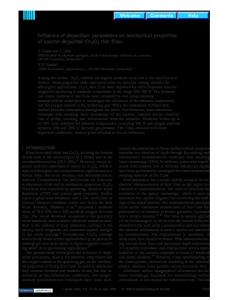Influence of the structure on the mechanical properties of electrodeposited metallic thin films
- PDF / 2,068,934 Bytes
- 6 Pages / 414.72 x 648 pts Page_size
- 69 Downloads / 349 Views
Influence of the structure on the mechanical properties of electrodeposited metallic thin films J.-L. DELPLANCKE*, R. WINAND*, J. DILLE"* and J. CHARLIER** *
Metallurgy - Electrochemistry Department, CP165
** Physical Metallurgy, CP194/03
Universit6 Libre de Bruxelles, 50 Avenue F.D. Roosevelt, B-1050 Bruxelles, Belgium
Abstract Production of thin (10 to 200 microns thick) metallic (Cu, Co and Ni-P) foils is performed by electrodeposition on various substrates. A competition between substrate-induced and electroplating-induced inhibition of crystal growth appears. Film structures observed by SEM, TEM and X-Ray diffraction are related to the mechanical properties of the films (stress-strain curves, microhardness and work hardening bend test). In some cases, copper thin films with a large number of submicron crystals are obtained. These films recrystallize at room temperature and their mechanical properties are completely modified by this ageing process. Introduction As pointed out in recent papers [1-2], the mechanical properties of thin to very thin films are difficult to measure. In order to avoid substrate interferences, the use of free standing films instead of constrained supported films is usually preferred. Electrodeposition on slightly oxidized metallic substrates [3] has been reported recently as a tool for the production of large (1 dm2 ) free standing metallic films, the oxide film acting as a parting agent for the film stripping. The purpose of this paper is on the one hand, to study the influence of the substrate (stainless steel, aluminum and oxidized titanium) on the microstructure of copper and nickel-phosphorus electrodeposited thin films and on the other hand to correlate the observed microstructures with the stress-strain curves obtained for the copper films. A comparison of three different tests (stress-strain curves, microhardness and work hardening bend test) for free standing cobalt electrodeposited foils with various microstructures is also reported. Experimental The commercially pure titanium substrates (IMI 115) are chemically polished in a hydrofluoric-nitric acid bath as described in a previous paper [4]. They are then anodized in order to produce a microporous thin oxide film [5]. The aluminum and 304 stainless steel substrates are carefully degreased with acetone and ethanol and then etched respectively in sodium hydroxide and nitric acid solutions. In order to control the hydrodynamics during the electrodeposition experiments, a channel cell is used [6]. Copper, nickel-phosphorus and cobalt films are deposited respectively from a copper sulphate bath [6], a nickel sulphate - nickel chloride - phosphorous acid electrolyte [7] and a cobalt chloride bath. Mat. Res. Soc. Symp. Proc. Vol. 308. @1993 Materials Research Society
608
Surface micrographs of the deposits are obtained by means of a Scanning Electron Microscope (SEM) JEOL JSM 820 while their textures are analyzed by Xray diffraction with a SIEMENS D 5000 apparatus. Higher magnifications of the deposit grain structures are ob
Data Loading...











